|
GROUP CAMPING - 1938 MODEL
By John I. Neasmith and Stanley M. Hawkins,
Associate Recreational Specialists.
Twenty-six organized camps and two tent camping sites
provided over 200,000 camper-days on Recreational Demonstration Areas in
Region I during the last summer.
Camping facilities were leased to a variety of
organizations, including Boy Scouts, Girl Scouts, Y.M.H.A., Y.W.H.A.,
Camp Fire Girls, Salvation Army, Y.M.C.A., Lutheran and Brethern
societies, League for Crippled Children, Optimist Club, Family Service
Association, Jewish Community Center and a State Commission of
Forestry.
Seven camps were operated for boys, three for girls,
fourteen were co-educational, two were for mothers and tots, and one was
for families.
In several instances, the official lessees served
other agencies. The South Carolina Commission of Forestry operated camps
on two Recreational Demonstration Areas within the state for such
organizations as The Salvation Army, Board of Christian Education of the
Methodist Episcopal Church, South, and Rural Farm groups. Three of the
Y.M.C.A. leases served underprivileged boys sent by service clubs,
newspapers, juvenile courts, and the Louisville "Cabbage Patch
Settlement."
A recent trend has been the incorporation of
community organizations for the leasing, management and operation of
camps. In New Hampshire, Rhode Island, Tennessee and Georgia such
agencies have satisfied the camping needs of several organizations in
nearby centers of population and in the state at large. It is expected
that an additional number of such "overhead" corporations will be
established and functioning before next season.
Most of the organizations provided a varied and well
balanced program, assuring to the participants a most satisfactory
camping experience, although some agencies encountered difficulty in
obtaining adequate funds, particularly those that had never before
attempted a camping program.
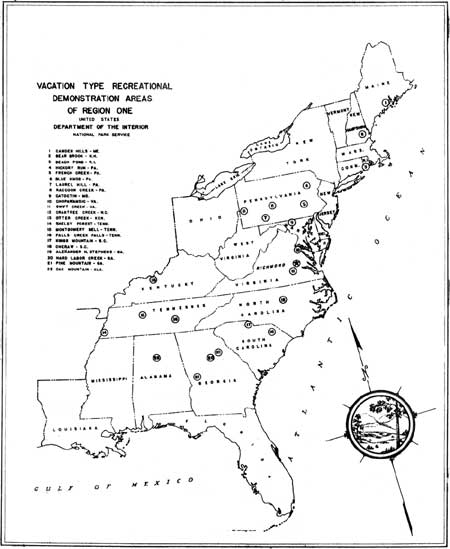
(click on image for an enlargement in a new window)
At the start, many of the camp directors found it
necessary to adapt themselves to the unit-type layout, since their
previous experience had been gathered in very compact groups of
buildings, and they missed the ability to step to the door and call any
camper or counsellor. They and their staffs quickly realized the
distinct advantages of the unit system and soon made necessary program
adjustments. By the end of the season, favorable reaction was
practically unanimous.
Most central building groups were ample for the needs
of the using organizations. The large administration buildings of the
earlier camps have not proved popular, although canteens located in them
have generally been used. Offices usually were maintained in dining
halls or staff quarters. In one case the administration building was
used as a craft shop. It is believed that the small office building now
recommended, when conveniently located, will be sufficient for most
organizations.
All agencies appeared to welcome the infirmary, but
few were used extensively. In instances where the camp was convenient to
nearby hospitals or sick cases were not permitted to remain overnight in
camp, a smaller building would have sufficed.
Quarters for staff and help were ordinarily adequate.
In some in stances, directors and assistant directors were permitted by
the lessees to bring their families to camp and infirmaries and staff
buildings were used as living quarters. After discussions with several
of the camp directors, it is not thought that these conditions will
prevail another year.
Recreation buildings, where available, were used to
advantage, but lack of this item did not appear to work a hardship on
the using agency. Several directors indicated desire for such a building
because of a program designed to meet community deficiencies.
Central shower houses, variously designed as to size
and equipment, were ample. The 275-gallon hot water tank with
appurtenant heater in which a low fire was maintained continuously
seemed to work better than the larger installations which were
ordinarily fired with scrapwood or rubbish a few hours before shower
time.
Garages were little used except for temporary
storage. Staff cars, when not on the road, were apt to be found in
parking area or service yard.
Dining halls and kitchens proved satisfactory to most
using agencies. The few cases of inability to maintain sufficiently low
temperatures in refrigerators were attributable to failure to follow
specifications rather than to faulty design.
The splendid adaptability of most camp directors to
available facilities was gratifying. The interest and cooperative spirit
of organization staffs in all matters of health, sanitation, safety,
better programs and standards were most heartening. Organizations
fostered and encouraged every effort which tended to raise standards of
past performance.
Health is an important result of camping experience
for growing children, particularly if each child may be maintained in
camp several weeks. At Catoctin, the Maryland League for Crippled
Children has completed its second year of camping program. All but two
percent of the 96 crippled children who spent eight weeks in camp were
wholly subsidized. Ranging in age from six to twenty-two, and from
families of very low income, their physical handicaps resulted from
infantile paralysis, spastics, spina befida, old bone infections and
accident cases involving amputation. Selected by a committee of
Baltimore physicians, they are treated throughout the school year
through the support of the League.
Initiation of this camping program has obviated lapse
during the summer of beneficial results accruing through the rest of the
year. Continuity of treatment also has permitted earlier termination
without fear of retrogression. As a result, the League has been able to
extend the benefit of its work to a greater number of children.
Again, at Laurel Hill, a program conducted by the
State Teachers College of California, Pennsylvania, was organized to
provide rehabilitation for boys and girls with stuttering lisping, sound
substitutions, nasality and allied speech disorders. In addition to
caring for the children's physical health, social adjustment of these
individuals, vitally important in speech disorders, was arrived at
through well directed recreational activities.
| DAY USE BEACH, SWIFT CREEK, VIRGINIA |
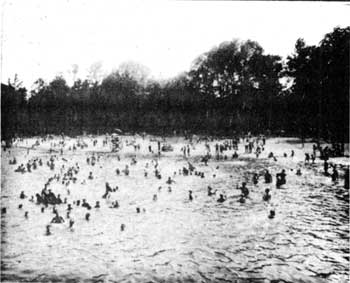
|
| HANDICRAFT- PERHAPS A HOBBY FOR LIFE, PINE MOUNTAIN, GA |
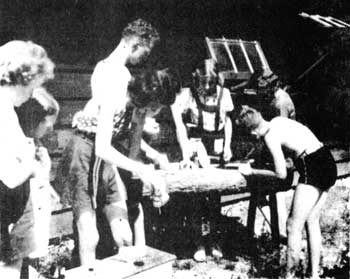
|
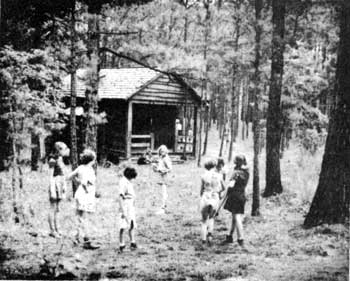
|
CAMP CLEAN-UP AND HOMEMAKING GO HAND IN HAND, CRABTREE CREEK, NORTH
CAROLINA. |
In this, the first speech rehabilitation program
conducted in the East, some of the results accomplished were
outstanding. Within a few weeks after entering camp, a twelve-year-old
girl who had never spoken an intelligible word had a vocabulary of over
250 words which she could speak as distinctly as any child. Other
instances were equally startling.
This camp also made a determined effort to plan and
execute a sound program for the development of future counsellors. In
cooperation with the camp director, the seven junior counsellors planned
and directed certain programs and were held responsible for the
leadership of all camp activities.
Many different methods of operation and management
were in use during the season, most of them improvements over the method
prevalent in 1937, which involved a complete change of staff with each
change in organization occupancy. Three typical setups will be discussed
in the following paragraphs.
At Otter Creek, Kentucky, the Louisville Y.M.C.A., a
strong organization in the community, operated probably the longest
season, opening early in June and closing September 15. In addition to
boys of their own membership, they served the Salvation Army, three
church groups, Fresh Air Fund boys subsidized by the two city
newspapers, and boys from the "Cabbage Patch Settlement" sponsored by
the Optimist Club.
The camp at Bear Brook, New Hampshire, was leased and
operated by New Hampshire Camps, Inc., which includes in its membership
the New Hampshire Farm Bureau Federation and 4-H Clubs, District
Y.W.C.A., and Girl Scouts. The operating staff of the parent
organization functioning for the entire season, was headed by a business
manager, who provided the water front director, nurse, and kitchen help,
and who further had complete charge of all physical facilities,
including maintenance of buildings and purchase and preparation of food.
Each participating organization brought in for its term of occupation a
director in complete charge of program for his organization, together
with those counsellors who lived in the units. This system practically
eliminated the end of period confusion previously attendant upon each
change of campers.
In South Carolina the State Commission of Forestry is
the agency which is later expected to assume the administration of two
Recreational Demonstration Areas within the state, at Cheraw and Kings
Mountain In order to become thoroughly familiar with the problems
connected with such administration, and with praiseworthy regard for the
benefits to the underprivileged citizens of the state, the Commission
rented and paid for the two camps on these areas. It furnished a
skeleton administrative staff, equipped the camps, and furnished all
meals. A very low fee was charged for such state service. In this way,
camping was made available to many organizations that could not have
afforded to set up a camp of their own. This method of operation proved
quite successful and it is hoped will continue.
The Chopawamsic area has provided an example of
diversified camping use. Two camps were in operation in 1936, three
during 1937 and four the current season, all campers coming from
Washington, D. C. Three of the 1938 camps were community supported, and
furnished not only food and leadership, but also transportation,
clothing, swim suits and medical and dental care. The staffs were drawn
from the best sources, some members coming from as far away as New York
City and the New England states. Two of the camps were operated for
Negroes and two for whites. Each race used a "mothers and tots" camp.
The remaining white camp was co-educational while the second Negro camp
was for boys only.
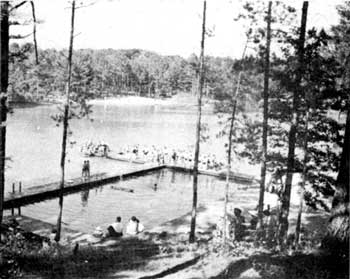
|
THE WATER FRONT, MOST POPULAR CAMP ACTIVITY, AT CRABTREE CREEK,
N.C. |
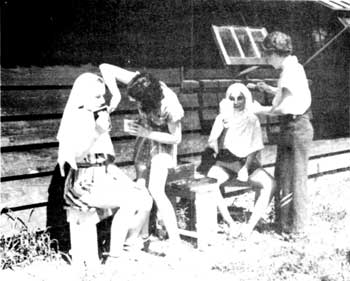 |
NOT A BEAUTY SALON, BUT MAKING UP FOR PAGEANT, PINE MOUNTAIN,
GA. |
| CANOEING, A NEW ADDITION TO CAMPING IN THE SOUTH CRABTREE CREEK,
N.C. |
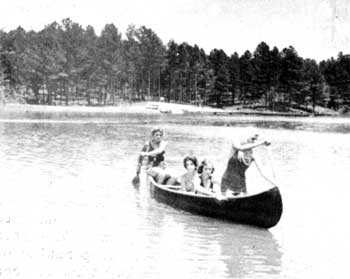
|
An interesting variation from camping precedent was
evident at Hard Labor Creek in Georgia. The camp was leased by the
Optimist Club of Atlanta, and turned over to the public school system to
operate for all boys of that city and of nearby communities. The schools
also will supplement their classroom work by sending groups to camp for
short periods during the coming fall and spring.
In the South for years camping facilities have not
been available on a scale comparable with those in the North. For this
reason the people of the South have not been as familiar with the
technique and benefits of camping as their more northerly brothers. It
has even been said that they would not camp if the opportunity were
provided. The use during the past season of sixteen camps on
Recreational Demonstration Areas south of Washington would seen to
disprove that theory.
After several years of effort in providing repeatable
demonstrations of adequate organized camping facilities located
conveniently to the large centers of population, it is now most
gratifying to discover that communities and previous non-camping
organizations are increasingly eager to be helped in working out plans
for the best use of such facilities. They appreciate the value of
returns to the communities which are realized from benefits derived by
individuals who are afforded camping opportunities.
It is a significant fact that community planning of
recreation and the solution of problems have been advanced several years
as a result of the action of the National Park Service in designating
Advisory Committees on Camping in the large centers of population which
are served by the Recreational Demonstration Areas. The interest of this
Service in the recreational and camping needs of these communities has
provided a much needed impetus to Councils of Social Agencies, Camping
Committees, and directors of Community Chests. It has crystallized many
problems which have heretofore been so nebulous that they have appeared
insurmountable.
At the eighth Annual Camp Institute held in 1937,
Marshall H. Levy, director of the Ann Arbor Boys Guidance Project, Perry
School, Ann Arbor, Michigan, reported:
"Camping is rapidly achieving its inevitable position
as a major social institution; it is destined to occupy in our
civilization a place comparable to our schools, churches, clubs,
commercial recreations, and the automobile as a pattern of human
activity and association. The more intelligently we relate the Camp to
all the other phases of the community of which it is an organic part,
the better will society be served."
The National Park Service, in its Recreational
Demonstration Project program, is in the forefront of this movement.
Through the close cooperation and personal contacts of our
representatives with state and community officials, the Service is
rapidly attaining a position of outstanding prominence in the field of
recreation and camping.
|

